The Recovery of Human Fat in the Cremation Pits
It is well known that several witnesses from Auschwitz describe cremation pits equipped with a system for the recovery of human fat flowing down off the human bodies into appropriate fat recovery pits or ditches from which it was drawn off by means of buckets and thrown back on the fire. Revisionists consider such a procedure impossible. Holo-blogger Sergey Romanov, in his text “Recovery of Liquid Fat from Pyres Is Impossible”[1] attempts to demonstrate that it was possible.
1. Romanov’s Arguments
Romanov reviews the testimonies of the following former inmate members of the Sonderkommando at the Birkenau crematoria: Joshua Rosenblum, Filip Müller, Henryk Tauber, Charles Bendel, Henryk Mandelbaum, Shlomo Venezia, Shlomo Dragon. He then sets forth his own arguments.
“Even if a pool of liquid fat is burning, this burning fat can still be collected and poured back on the pyre. So this is much ado about nothing.
The only half-controversial issue here is the description of merely ‘boiling’ and ‘sizzling’ fat, apparently without large-scale burning, as seems to be implied by only two witnesses, Tauber and Müller. Even if one were to prove that these descriptions are inaccurate or embellished, this wouldn’t impeach the rest of the testimonies, which merely mention the use of fat but don’t dwell on the question of whether it was burning or not. But are Tauber’s and Müller’s descriptions trustworthy?”
After citing the description of my experiments using animal fat, mentioned below, Romanov comments:
“So many words. But what exactly did Mattogno prove? At best that the fat dripping from a burning corpse would probably ignite, if it was also surrounded by sufficient heat. Though it should be kept in mind that in certain situations fat would also flow without igniting; for example, if a corpse is burning and corpses next to it are not yet aflame and have wounds in ‘fatty’ areas, the fat may flow out of these wounds without igniting just on account of nearby heat, because the melting temperature would be reached, but not necessarily the ignition temperature, and the corpse skin wouldn’t have to be burned in order to free the liquid fat; in the initial phase of incineration this fat probably would not meet a ‘bed of embers’ below. But let’s assume for the sake of the argument that Mattogno is correct in that the liquid fat exuding from a burning corpse will immediately catch fire.
The main problem with Mattogno’s experiments is that he doesn’t really consider the situation described by the witnesses. Let’s try to reconstruct it.
We have an incineration pit with a sloped trench running through it which connects to a separate smaller collection pit. At different times in different pits the configurations might have varied slightly (two collection pits, two trenches, etc.). The pyre is built in the incineration pit proper, above the trench. The pyre is lit and after some time the fat begins to flow from the corpses. To repeat, let us assume that it immediately ignites.
As we know, just because the fat is ignited does not mean that it is immediately destroyed. The burning fat still flows. Thus, Mattogno’s contention that it wouldn’t be able to reach the collection pits because of a bed of embers is strange, to say the least. It would flow between the embers. Maybe in late stages of incineration there would be so many embers on the bottom that they would absorb all the fat, but we’re not talking about late stages. Not to mention that it takes time for a bed of embers to form in the first place.
The burning fat would flow to the trench from the presumably sloped sides of the bottom of the incineration pit. Then it would flow in the sloped middle trench in the direction of the collection pit.
How much burning liquid fat would flow in the direction of the collection pit? We can’t know for sure, but let’s consider a pyre of 2000 bodies, with an average body being 45 kg. This body mass accounts not for emaciation (clearly, you won’t get much fat from an emaciated person) but for children’s bodies. I should note here that most Jews arriving in Auschwitz-Birkenau in the periods in question weren’t in the best shape, but they weren’t emaciated either, probably unlike the majority of Jews taken to the Aktion Reinhard(t) camps.”
Romanov then cites a second source according to which the fat contained in the corpse of a normal adult ranges from 10-20%, and then continues:
“To be ultra-conservative, let’s take 7% as our average. Then we’re already dealing with at least 6300 kg of fat. That’s quite a lot and it is probably an underestimate (it would be 9000 kg if we assumed 10%, 13500 kg for 15%, and so on). Much of this fat, maybe even most of it, would undoubtedly burn before reaching the collection pit. But there is nothing to suggest that hundreds, if not thousands of kilograms of fat would not reach it.
The burning fat has reached the pit. What happens now?
One of the leading specialists in forensic investigation of fires, Dr. John DeHaan, who, together with his colleagues, has burned quite a lot of corpses, both animal and human, in controlled environment, has this to say about combustion of human fat in his and Elayne Pope’s presentation ‘Combustion Properties of Human and Large Animal Remains’:
’Fat only burned where it had been rendered and absorbed into carpet, towel, blanket, clothing or charred wood.
And under the Figure 6 (my emphasis):
Charring of carpet or wood flooring supports the wick effect necessary to sustain combustion of rendered body fat.
In the concluding section of their article ‘Combustion of animal fat and its implications for the consumption of human bodies in fires’ (PDF file, DeHaan, Campbell and Nurbakhsh, Science & Justice, 1999, Vol. 39, No. 1), DeHaan and co-authors state (p. 38):
It is clear that animal fat (and by extension human body fat, which is said to be very similar to the subcutaneous pork fat used here) can contribute to the fuel of a compartment fire. Its combustion depends on substantial preheating by an external heat source and the availability of a porous wick (such as charred cellulosic material).
In an e-mail correspondence Dr. DeHaan further elaborated on this point (message dated 11.11.2009):
Yes, unless there is a great deal of external radiant heat flux to keep the pool of fat at a very high temperature, it will not sustain combustion on a flat, non-porous surface. Just like candle wax will only burn on a smooth table top if you continually play a blow torch across it. We have had instances where a very corpulent body has released so much rendered fat that it forms a pool or stream that supports flame in the fire environment that a pool fire existed it is because the external fire was able to heat the liquified fat well past its flash point. (One commercial crematorium was burned down as a result, and others have been damaged!) Charred wood flooring or very porous concrete or lava-stone have been seen to act as a wick, so the nature of the floor is important.
Thus, animal fat, although a good fuel, is unable to sustain its own combustion unless there is a sufficient external source of heat or a suitable porous wick is present.
The witnesses don’t give precise distances of the collection pits from the pyres (Müller seems to have indicated ‘several meters’, although he is vague), thus we have a right to assume that the collection pits were far enough from the pyres for the fat in them not to have been re-ignited by heat radiation.
This is a crucial point, since in none of his experiments has Mattogno considered a situation in which the external source of heat radiation is absent. Moreover, his point about the impossibility of collecting the fat because of the high temperature of the pyre is also moot.
Romanov comments:
“Thus without a suitable porous wick and without the external heat source the fat would stop burning soon. If there was nothing to serve as a wick in the collection pits, and if they were far enough from the pyre, then the fat in them would not have been ignited by an incoming burning stream.”
Now let’s consider the case in which a wick would be present. In this case a candle can be a good analogy. In fact, in old times quite a lot of candles were made out of fat. You can make your own lard candle and verify that when the fat around the wick melts and forms a pool, this liquid fat does not ignite, despite the flame being near it. Rather, only the wick itself burns, while absorbing the liquid fat.
Romanov then examines the example of the possible presence of material functioning as a wick in the recovery pits, something that can only be discussed hypothetically. He then attempts to justify two allegations contained in the statements by Tauber and Müller, which in my opinion are perfectly irrelevant, just as is the question of the boiling fat, which according to him is the “only half-controversial issue”!
2. Presentation of the Problem
According to Holocaust historiography, beginning in mid-May 1944, when numerous convoys of Hungarian Jews were arriving at Auschwitz almost every day, the crematoria at Birkenau could not handle the cremation of the enormous numbers of “gassing victims,” so cremation pits were dug in the courtyards to the north of Crematorium IV and in the courtyard of “Bunker 2.” According to Franciszek Piper [chair of the Historical Department at the Auschwitz State Museum- ed.], 10,000 bodies a day were cremated in these pits, 5,000 in each of them.[2]
Here, historically, is where the problem arises. As I showed in a specific study, to which the reader may refer,[3] the air photographs of Birkenau taken between May and September 1944 do not show any cremation pits in the vicinity of the so-called “Bunker 2” and only a small area, about 50 meters square, which appears to be emitting smoke, in the courtyard of Crematorium V. Assuming the data adopted by Müller, to cremate the 10,000 bodies per day referred to by Piper would have required cremation pits with a total surface area of 3,000 square meters,[4] 60 times as much. In reality, due to the high water table, the necessary surface area would have been 9,000 square meters, 180 times larger than that attested to by the aerial photographs!
The second problem is that Holocaust historiography does not know, and cannot say, how many cremation pits existed and how big they were, at the two locations mentioned and in total. This is because the statements of the witnesses are contradictory in this regard. The following table, for example, shows the eyewitness testimony relating to the alleged pits near Crematorium V:[5]
| Witness | # of pits | Length [m] | Width [m] | Depth [m] |
|---|---|---|---|---|
| Tauber/1 | 4* | ? | ? | ? |
| Tauber/2 | 5 | ? | ? | ? |
| Mandelbaum | ? | 30-35 | 15 | ? |
| Jankowski | 2 | 20 | 2 | 2.0 |
| Dragon | 5 | 25 | 6 | 3.0 |
| Bendel | 3 | 12 | 6 | 1.5 |
| Müller | 5 | 40-50 | 8 | 2.0 |
Rosenblum, cited by Romanov, spoke of an imprecise number of cremation pits, dug in support of the crematoria, measuring 10 x 5 x 2 meters in depth.[6] They did not specify where they were, but, for their functioning, they could only have been the alleged pits near V. I will not dwell on the contradictions in their statemnts relating to the capacity of the pits and the duration of the cremation procedure.[7]
I recall that in the courtyard of Crematorium V there was a cremation site measuring 50 meters square, more or less square, therefore each side measured approximately 7 x 7 meters. How reliable are these witnesses?
3. Reconstruction of the “Real Situation” (that is, the “Authentic” Fairy Tale) of the Cremation Pits
Romanov asserts that I have not considered “the real situation described by the witnesses”; but it is he who, in his reconstruction, does not take account of it, lucubrating on the basis of purely theoretical or hypothetical presuppositions. This is so true that he neglects the essential data in the absence of which any reasoning becomes entirely random: dimensions of the cremation pit, length of the fat-recovery conduit and the number and disposition of the bodies and the wood. This data is supplied by Müller and Tauber.
The first declares that one cremation pit measured 40-50 meters x 8 meters, x 2 meters in depth; from the center, two channels 25-30 centimeters wide ran transversely along a slope towards the two sides of the pit and each one terminated in a “collection ditch”, dug into the bottom of the pit.[8] The disposition of the pyre was as follows: one layer of old railway ties, sawn beams, pieces of wood and sawdust (Sägespäne), covered with dry fir branches, then, on top of that, a layer of 400 bodies, one next to the other in four rows; then, another two similar layers, so that the pyre had 1,200 bodies in it.[9] The last layer reached about half a meter above the edge of the pit.[10] The cremation took 5-6 hours.[11]
Tauber, by contrast, indicates the dimensions of the fat recovery pit: m 2 x 2 x 4 in depth.[12] Romanov, who quotes the related passage, observes that it “could not have been 4 meters deep due to the high water table,” which, according to him, at the time, permitted the digging of pits [only] 2-3 meters in depth, a claim that is debatable, to say the least.[13] For the moment I shall limit myself to noting that the diagram of the Zentralbauleitung no. 2534/2 dated 15 June 1943 relating to the provisional decantation installation (“Provisorische Erdbecken“) of Bauabschnitt III (Construction Sector III) at Birkenau shows that the water table was at a height of 232.51 meters, the surface of the ground at 233.71 meters and the bottom of the decantation basin at 231.01 meters.[14] Therefore, the water table was 1.20 meters below the surface of the ground and the collection basins were 2.70 meters deep.[15] It is obvious that it would not have made any sense to dig collection basins 2.70 meters deep if the water table had been shallower. On the other hand, we know that on 2 June 1944 (in the midst of the alleged cremation pit operation) Bauabschnitt III was still swampy (sumpfig), so much so that 14 barracks that had been built there could not be lived in for fear of contamination of the water table,[16] which confirms the depth stated above: 1.2 meters.
It follows that all the eyewitness statements alleging a depth of 2-3 meters are unreliable. Let’s hope that Romanov does not claim that the witnesses (poor souls!) got confused and couldn’t tell the difference between 1.2 and 2-3 meters!
But let us assume as a hypothesis that the maximum limit was 3 meters.
The reconstruction of the “real situation described by the witnesses” simply cannot do without diagrams, without which one runs the risk of getting lost in idle chatter, which is precisely what happened to Romanov.
It should furthermore be stated that he concerns himself with the extremely meager description of the cremation pits supplied by Müller at the Auschwitz trial:[17]
“The depth of these pits was probably two and half meters.”
“And they were constructed so that each pit had a sloping channel on the bottom.”
“And at the sides, still further away – a few meters – these holes had been dug.”
He also stated that the pits were “35, 30 perhaps 40 meters” long and “6-7 meters” wide,[18] which is in obvious contradiction with everything written by the witness in the book: 50 x 8 x 2 (maximum dimensions) against 40 x 7 x 2.5, but let us not worry about it (since Romanov will no doubt find a “rational” explanation for this). But in his book, where he supplied the most detailed description of the structure of the cremation pits, Müller made no mention of this distance between the pyre and the human-fat-recovery pit. Assuming the average measurements adopted by him indicates a cremation pit 45 meters long, 8 meters wide and 2 meters deep. From the center, two channels 27.5cm wide were dug lengthwise, issuing into two human-fat-collection pits. These channels were presumably lined with brick, because, according to Müller, “bricks” and “cement” were used to build them, among other things.[19] For the slope, we may take that from the edges of a traditional road with a crowned surface, intended to enable the rain water to flow laterally, with two lateral sections sloping from 6 to 3%.[20] But, liquid fat has a greater viscosity than that of water.
As regards human fat, it is difficult to obtain reliable data, but we know what ox fat, at 100°C, has a viscosity coefficient 1.7 times greater than water at 20°C;[21] we will therefore have to assume the maximum slope angle of 6%.
If, therefore, the cremation pit was 45 meters long, and the two human-fat-recovery pits measured 2 meters across each (Tauber), half the cremation pit would have been 22.5 meters, 2 of which were occupied by the human-fat-recovery pit; the human-fat channel descended to the depth of (20.5 x 0.06 =) approximately 1.2 meters from the bottom of the cremation pit, or 3.2 meters below the edge of the pit. Since a bucket with a capacity of 12 liters has a height of 28.5 centimeters (and a circumference exceeding 31),[22] the minimum depth of the human fat collection pit required to be able to reach the presumably liquefied fat was 30-40 centimeters, therefore its depth below the level of the ground was 3.5-3.6 meters. Well into the water table.
Figure 1 shows a schema (not to scale) of this construction system.
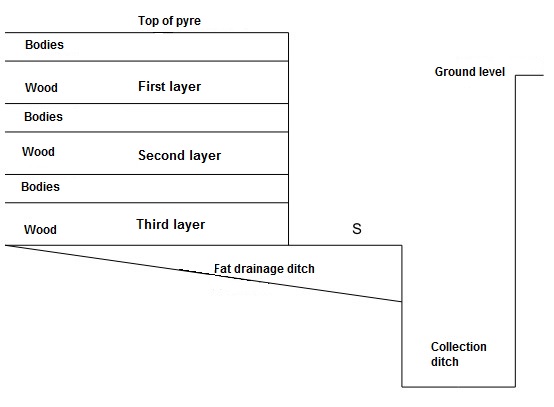
Müller’s affidavit at the Auschwitz trial, if it were understood to mean that the human fat collection pits were separated from the cremation pits and were located a few meters further away from the edges of the cremation pit in each case, makes no sense in practice. As shown by the related diagram (Figure 2), in this case the human fat channel would have been even longer. Assuming for example a distance of 3 meters, it would descend to a depth of (23.5 x 0.06 =) approximately 1.4 meters, down to 3.4 meters from the surface of the ground. It would be necessary to dig a pit next to the cremation pit from the level of the ground 2 x 2 x 3.7 meters deep (in this case 0.3 meters deeper than the mouth of the human fat channel), but by hand it would be impossible to excavate the stretch of channel linking the two pits together, because this would start from a depth of (22.5 x 0.06 =) approximately 1.3 meters from the edge of the cremation pit (Point B of Figure 2) up to approximately 1.4 meters from the edge of the collection pit (Point D), because, from the level of the ground, it would be necessary to excavate – by hand – a channel 25-30 centimeters wide and from 3.3 to 3.4 meters deep.
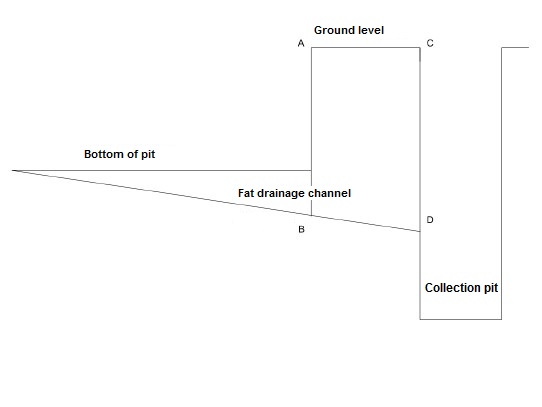
The second possibility is that the distance of several meters would relate to that running between the pyre and the edge of the human fat collection pit (S in Figure 3). In this case the pyre would have been shorter. According to the data mentioned above, half the pyre would have been (22.5 – 2 – 3 =) 17.5 meters, or 35 meters in all.
Since the bodies were arranged on the pyre in 4 rows of 100 bodies each, for each body there was an average space of only 35 centimeters, which confirms that the distance between the pyre and the collection pit could not in any case have been much greater than 3 meters. And since the pyre, which was 2.5 meters high, would have collapsed due to the effects of the fire, moving closer to the collection pit, one can be certain that the heat would have been more than sufficient to ignite any possible fat deposited in said pit. I will return to this question below.
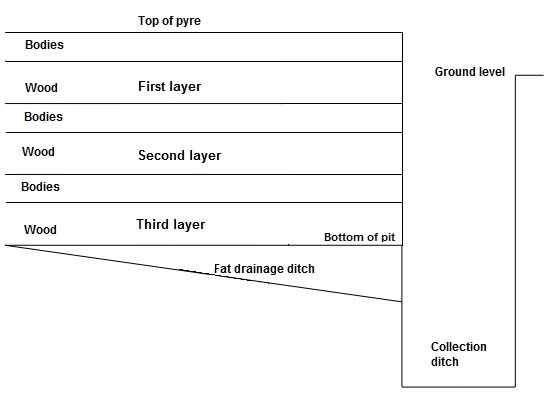
The data supplied by Müller also permit us to estimate the quantity of wood employed. The three layers of wood and bodies were (2.5 ÷ 3 =) thick, approximately 0.8 meters each.[23] Assuming 0.2 meters per body, there remain 0.6 x 3 = 1.8 meters for the wood, corresponding to a volume of (35 x 8 x 1.8 =) 504 cubic meters.
1 cubic meter of ordinary wood in a pile weighs from 340-450 kg,[24] assuming the lowest value, 504 cubic meters correspond to (0.340 x 504 =) approximately 171 tons, with a thermal coefficient of 3,000 Kcal/ kg. This, therefore, means (171,000 ÷1,200 =) 142.5 kg for every cadaver, and per 1 kg of body weight, according to the average weight adopted by Romanov, (142.5 ÷45 =) 3.1 kg of wood.
It should also be noted that Venezia’s description, adopted by Romanov, is even more nonsensical. He states:[25]
“The pits were sloping; the human fat produced by the burning bodies ran along the bottom to a corner, where a sort of hollow had been dug to collect it. When the fire threatened to go out, the men took a bit of this human fat from the hollow and poured it over the bodies to get the flame started again. I have never seen anything like it, except here, in the pits at Bunker 2.”
For the witness, therefore, there was no human-fat-collection channel dug along a slope; rather, the very bottom of the pit itself constituted the sloping channel, as I have illustrated in Figure 4.
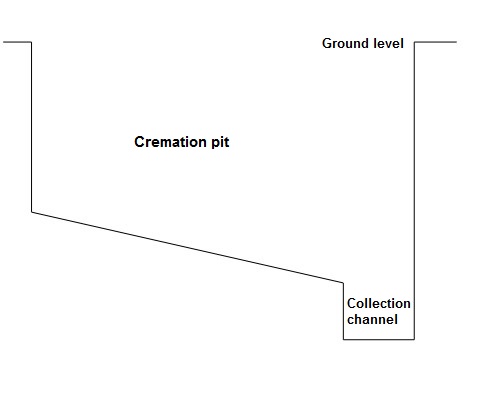
The fact that Romanov accepts as realistic the case of a “cremation pit with one sloping human-fat-collection channel running lengthwise, connected to a small separate human-fat-collection pit” and considers the possible existence of two human-fat-collection channels [merely] a “slight variant”, is ample proof of his confusion. The first case, in fact, would be similar to that described by Venezia: one single channel would run from one edge of the cremation pit and would issue into the human-fat-collection pit at a depth of (45 – 2) x 0.06 = approximately 2.6 meters below the bottom of the pit (2 + 2.6 =) 4.6 meters below the ground level; the collection pit would have been at least 0.3 meters deep, therefore its depth from the surface of the earth would amount to 4.9 meters.
4. The Quantity of Fat Theoretically Recoverable
Let us now examine Romanov’s conjectures regarding the quantity of fat contained in the bodies and that theoretically recoverable.
He assumes 2,000 bodies with an average weight of 45 kg with a fat content of 7% of body mass, a percentage which he considers “underestimated”, so that he arrives at a final proposed quantity of 15%. Since “it is not uncommon to find fat percentages below 10 percent among male cross-country skiers and below 12 percent in female [skiers],”[26] it is difficult to imagine that the Hungarian Jews would possess a percentage exceeding 10%. The average weight of the bodies, on the other hand, is too low, so I have assumed the weight of 60 kg which I have calculated elsewhere, also assumed by Robert Jan van Pelt.[27] As to the number, why does Romanov speak of 2,000 bodies when the most important witness only mentions 1,200?
These data show that the fat contained in the bodies would have amounted (1,200 x 60 x 0.1 =) to 7,200 kg. The specific weight of human fat is 0.903,[28] therefore 7,200 kg would correspond to approximately 8,000 liters. First of all, let us examine the purely theoretical case of the human fat in the cremation pit: 8,000 ÷ (41[29] x 8) = approximately 24 liters per square meter, corresponding to a uniform depth of 2.4 centimeters. By virtue of the viscosity of the liquid fat, if such a quantity were poured uniformly into a concrete tank identical to the above-described cremation pit, only a small part would flow into the channel and then only if the bottom sloped from both sides towards the center, as I have illustrated in Figure 5. Romanov realizes the difficulty, and speculates that the sides of the bottom of the cremation pit were “presumably sloping”, but neither Müller nor any other asserts anything of the kind.
On the other hand, the bottom of the cremation pit consisted of sandy soil, which would have easily absorbed the little more than 2 centimeters of liquid fat.
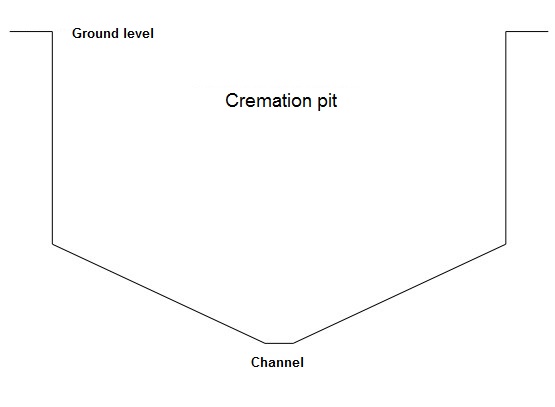
It therefore follows with certainty that the fat would only enter the channel if it fell directly into the channels from above, as (41 x 0.275 x 24 =) 270 liters of fat could be expected to do based on the aggregate area of the channels. But if the human fat recovery pit measured 2 x 2 meters (Tauber), then the depth of the fat in the collection pit would amount to (0.270 ÷(2 x 2) =) approximately 7 centimeters. Furthermore, I would like to introduce a reality check: the liquid fat [would] pass through as many as three layers of wood, approximately 504 cubic meters, equal to approximately 171 tons. Some part of the fat would adhere to the wood due to the force of cohesion between the molecules of fat and the molecules of wood, [while] the rest would be absorbed by the sawdust and sandy earth of the bottom of the pit. Only the part of the human fat indicated in the calculations above would flow into the channel, while the level of fat collected in the collection pit would amount to less than 7 centimeters.
The third case to be examined is the “real” case (according to Müller’s account). Here, a distinction should be made between two phases: that of the ignition of the pyre and that of its full rate of burn.
Allowing for the sake of argument that the situation mentioned by Romanov was really possible, i.e., that part of the fat from the bodies could flow into the pit without catching fire, this would have been true of the subcutaneous fat only. In a specialist text cited by Romanov we read:[30]
“Subcutaneous body fat constitutes the principal source of heat, but it must be exposed (through a laceration of the skin) and rendered liquid in such a way that it may be absorbed into porous materials functioning as a wick.”
Surely Romanov, when he speaks of “wounds in ‘fatty areas’” of the bodies, is referring to this passage.
Subcutaneous fat forms only part of body fat, which is also found in the bones, the internal organs of the body and the brain.[31] The subcutaneous fat flowing out would have partly adhered to the wood, and would have been partly absorbed by the sandy earth, so that only a quantity greatly less than the 270 liters calculated above would actually have flowed into the human-fat-collection pit, corresponding to a volume much less than that in the second case.
Such an eventuality is nevertheless proven impossible by one of my experiments involving the combustion of animal flesh and fat.[32]
PHOTOGRAPH 1 shows an improvised oven constructed by myself. I placed 10.8 kilos of beef on the upper grill, with an initial charge of 4.5 kilos of wood (followed by successive charges as needed) on the grating. Over the course of the experiment I noted the following:[33]
“The fat, falling in the pan placed beneath the burning wood, ignited immediately and burned with an intense flame (see Photograph 9, taken after 15 minutes). The meat caught fire after one hour. Two hours later, the meat was still burning with an intense flame.”
PHOTOGRAPHS 2 and 3 show that, although the meat wasn’t even charred, the fat flowing down off of it was already aflame. The structure of the improvised oven corresponds, in scale, to a cremation ditch open to the front, therefore the results are readily applicable to the present case. They are all the more applicable due to the fact that the percentage of fat employed was more than double that which would exist in the cremation pits (10% of body weight). For the experiment, I used the following:
| Bone and cartilage | kg | 4.1 |
| Visible fat | kg | 2.1 |
| Meat waste | kg | 1.9 |
| Internal organs | kg | 2.7 |
| Total | kg | 10.8 |
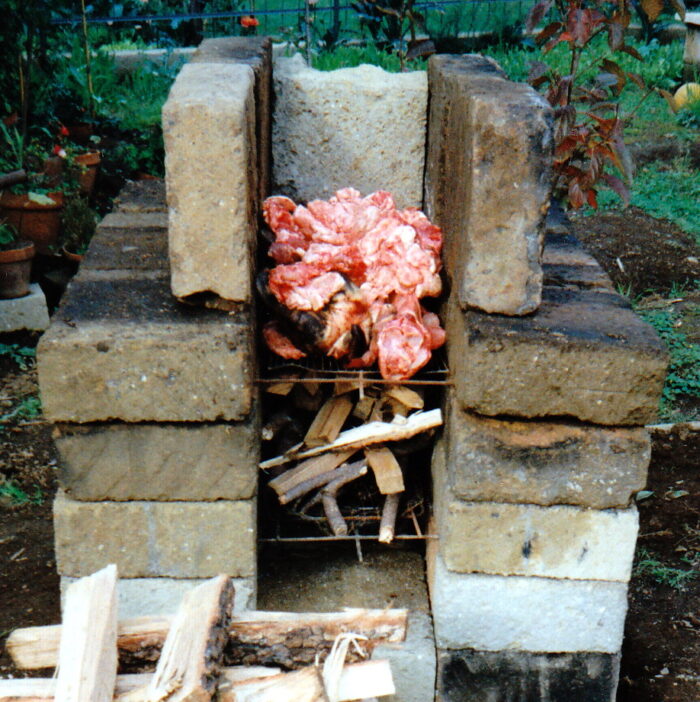
© Carlo Mattogno
The visible fat was approximately 19.4% of the total weight, in addition to the fat contained in the remaining mass, so that the effective percentage of fat may be estimated at 25-30%. Photograph 1 leaves no doubt in this regard.
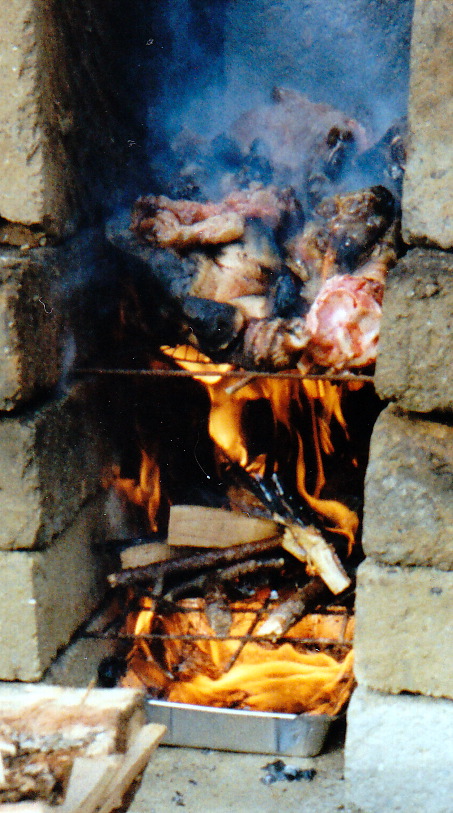
 PHOTOGRAPH 2 and 3
PHOTOGRAPH 2 and 3© Carlo Mattogno
Romanov’s claim that “there is nothing to indicate that hundreds, if not thousands, of kilograms of fat” could not have reached the human-fat-collection pit, is obviously absurd.
Liquid human fat, therefore, could under no circumstances flow into the collection pit.
5. The “Wick Effect”
But even assuming for the sake of argument that a certain quantity of liquid human fat had actually been collected in the appropriate collection pits in one of those many miracles with which the eyewitness testimonies are filled, what would have happened in actual fact?
Romanov, as we have seen, calls upon experiments performed by DeHaan and his collaborators to assert that the liquid fat “is unable to sustain its own combustion unless there is a sufficient external source of heat or a suitable porous wick is present.”
The experiments in question were intended to ascertain the contribution of human fat to a fire of limited proportions in which a human body was burned with little fuel and whether or not the fire could be sustained due exclusively to the heat produced by the combustion of the human body fat involved. According to Romanov, the situation of the human-fat-collection pits would resemble the situation illustrated in Photographs 4 and 5:
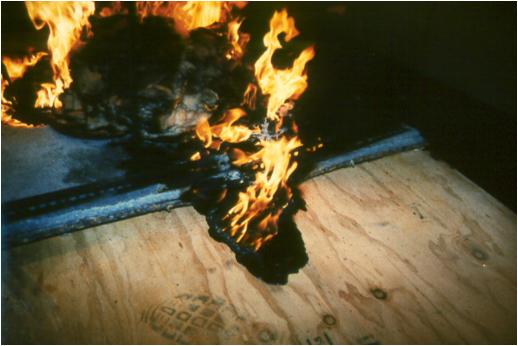
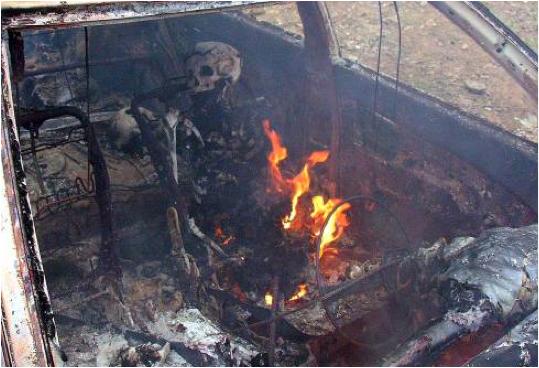
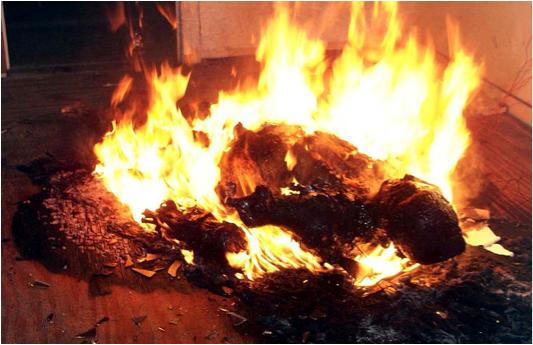
But it is obvious that burning a body on a carpet is one thing, while a cremation pit containing 171 tons of burning wood is another. In the animal-fat combustion experiments performed by DeHaan and mentioned by Romanov,[37] the maximum temperature recorded was 911°C.[38]
Over the course of a subsequent experiment, DeHaan recorded a maximum combustion temperature of 880°C for the pork fat and 913°C for human fat.[39]
In an article relating to other experiments, DeHaan writes, together with two collaborators, that,
“Temperatures in excess of this threshold would produce products of pyrolysis and products of true combustion following the self-ignition.”
He then adds:[40]
“[T]he chromatograms of human fat burnt in a microfurnace at 500°C were very strictly comparable to those produced by a large mass of fat from a human body burnt in a house fire.”
According to the manual of John H. Perry, a certified engineer, the ignition temperature of pork fat[41] is 343°C, but its flash point is 184°C.[42] In practice, [at temperatures] above 355°C, human fat begins to burn spontaneously in a continuous manner and without any contribution from an external heat [source] and above 185-190°C the liquefied fat emits vapors in such quantities that they burn if ignited.
The “wick effect”, as shown in Photographs 4 and 5 occurs only when part of the liquefied fat absorbed by a support material reaches the flash point. On the other hand, when the fat is all subjected to temperatures exceeding 185-190°C, the situation which results is that shown in Photographs 2 and 3. When the temperature exceeds the flash point of the fat, the latter develops inflammable vapors over its entire surface which burn with the formation of an intense flame, as seen in Photographs 7 and 8, relating to two experiments I conducted.
I placed an aluminum pan containing 250 grams of lard on the floor of the ash box of a furnace open to the front. The wood (fuel) grate is located 25 centimeters above the floor of the ash box. As it is constructed of a metallic mesh with mesh openings measuring 2 x 1 cm, the grate only allowed minute smoldering embers to fall into the pan. The fat contained in the pan became liquefied and started to boil due to the heat radiated from the hearth; the vapors formed from the fat ignited rapidly, burning with a bright flame (see PHOTOGRAPH 7).
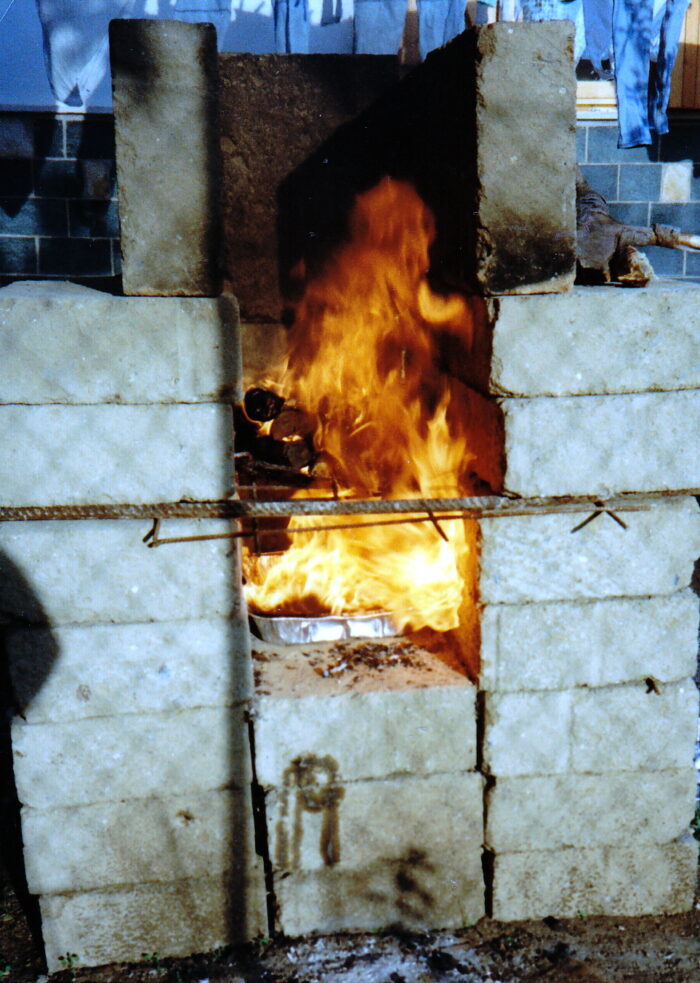
I placed an aluminum pan containing 500 grams of lard on the combustion grid of a furnace open to the front and to the top (see PHOTOGRAPH 8). The combustion grid was located 25 centimeters above the grate. After I ignited the wood in the hearth, the lard liquefied rapidly and began to boil; the vapors caught fire, producing very intense flames approximately 80 centimeters high. The combustion lasted approximately 2 minutes.
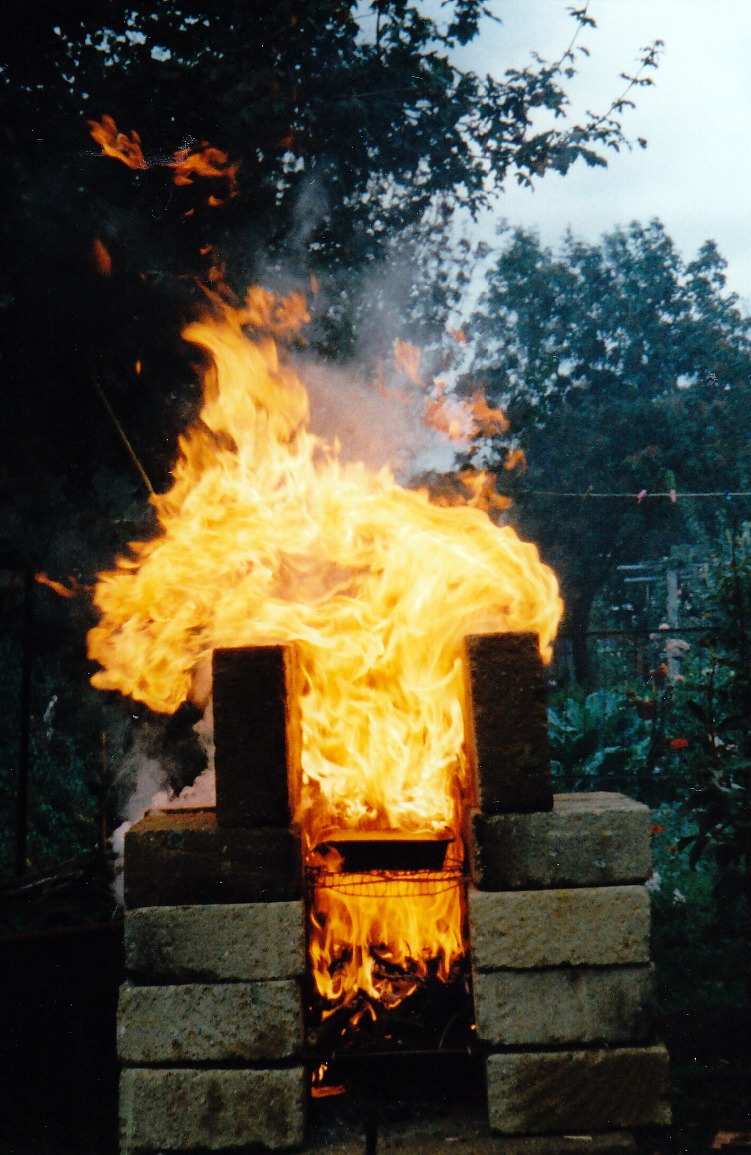
© Carlo Mattogno
Returning to Romanov, he organizes his argument around 2 points. The first is the claim that liquid fat “would flow between the embers.”
An obvious absurdity, if one considers the question in concrete terms. PHOTOGRAPH 9 shows the bed of embers resulting from my combustion experiment in a small pit (0.85 x 0.50 x 0.60 meters (in depth) using 15 kg of beef with 52.5 kg of wood after one hour.
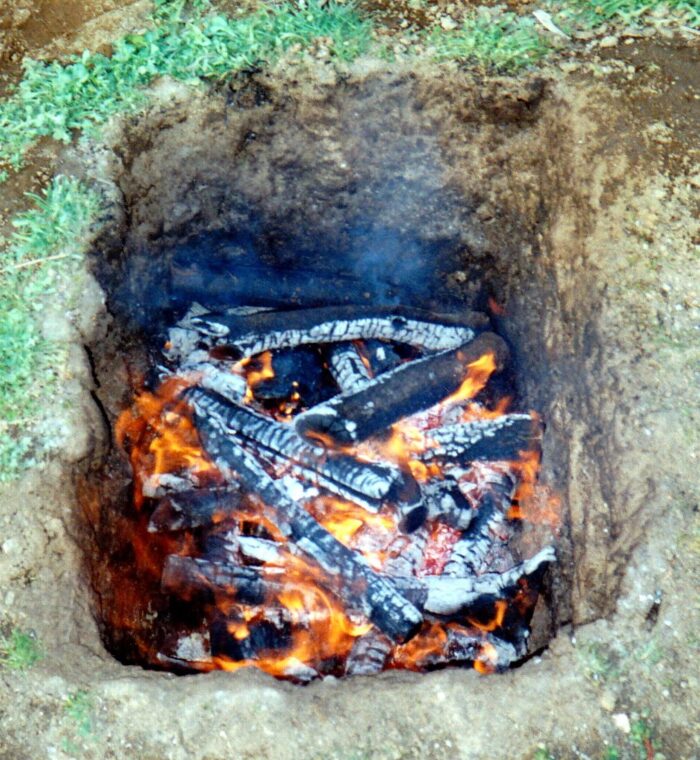
© Carlo Mattogno
After 16 hours, the temperature of the embers was still approximately 320°C. Therefore, according to Romanov, from the liquefied fat (what is more, this is a risible quantity, as I demonstrated above) flowing on these embers, they would have traversed them without catching fire! This is also in conflict with the “wick effect”, since all the conditions exist for a total combustion of the fat: an adequate quantity of carbonized wood and ashes (the “wick”), the flash point of the fat.
In this situation, the worst-case scenario would produce a situation analogous to that of my experiment illustrated by PHOTOGRAPH 10.
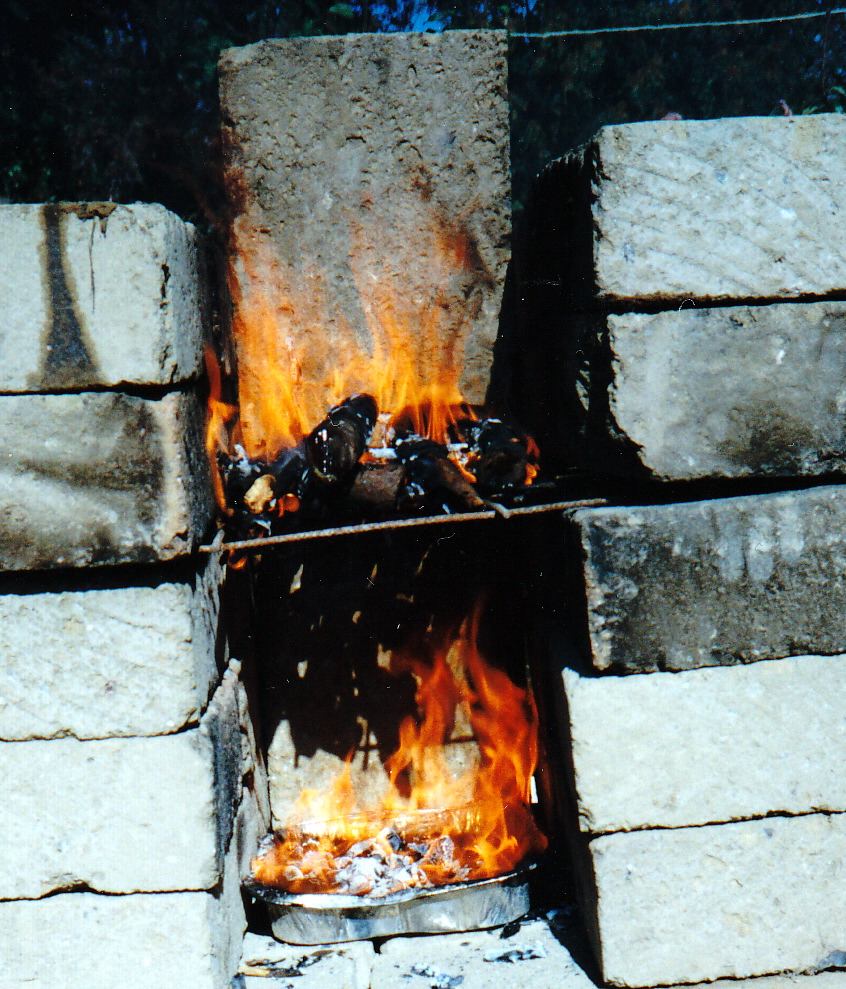
© Carlo Mattogno
The experiment was conducted in a furnace of tuff blocks open to the front and top. I placed an aluminum pan containing 250 grams of lard on the floor of the ash box and installed a metallic grid with mesh openings 10 x 10 centimeters wide located 28 centimeters above the level of the ash box. I then ignited the wood on the grate.
When the combustion became intense, the embers began to fall into the underlying pan; the fat in it first became liquefied then was absorbed into the ashes and burned with a flame which was somewhat less intense, but lasted longer (approximately 15 minutes), like the wick of a kerosene lantern (see PHOTOGRAPH 10).[43]
Let us go on to the second point. For Romanov, by virtue of the “wick effect”, the liquefied fat miraculously flowing into the human-fat-collection pit would not burn (at least not entirely).
Another obviously absurd claim, if one considers that the wood on the pyre would have developed a heat flow at least 17,000 times greater[44] than that to which DeHaan exposed his fat samples and that the burning of a pig carcass (comparable to a human body) causes recorded temperatures of 813°C. Under such conditions, any human-fat-collection pit, even at a distance of several meters away from the pyre, would rapidly reach the flash point as well as the fat ignition temperature. Therefore, the point brought up against me by Romanov, according to which my experiments did not take account of the “situation in which the external source of radiant heat is absent”, is obviously nonsensical. The very opposite is the case: it is he who has failed to take account of the situation in which the radiant heat flow is 17,000 times higher than that employed by DeHaan.
The claim that the fat hypothetically contained in the pits “would not have been ignited by a burning stream” which would have arrived there is therefore clearly absurd.
To summarize, the fat flowing from the bodies in a cremation pit would burn immediately, even during the initial phase, when the bodies are still more or less intact (Photographs 2 and 3).
The “wick effect” is irrelevant to a cremation pit, because the temperature in the pit would be such as to exceed the flash point and ignition temperature of the fact, so that it would necessarily burn with an intense flame (Photographs 6, 7, 8).
The liquefied fat cannot flow between or through the burning embers without catching fire; in the worst-case scenario it would burn with a moderate flame and more slowly over its entire surface (PHOTOGRAPH 10) and not at a single point.
6. Collateral Problems
The recovery of the human fat as described by former Auschwitz inmates also presents insuperable practical problems. How was it possible to collect the hypothetical liquid fat by means of a bucket attached to a long pole, standing on the edge of a cremation pit with a total radiant heat of 2,148,200 MJ and a minimum temperature of 600°C?[45]
There is also a less serious general problem: what was the purpose of the collection of the human fat? According to the witnesses, it was to accelerate the combustion of the bodies (Rosenblum, Tauber, Bendel, Mandelbaum) or to reignite the flames on the pyre (Venezia, Dragon). This presupposes that the human fat flowing down from the bodies into the pits would [otherwise] have been wasted, that it was irrelevant in the total balance of combustion, otherwise the collection would have made no sense. In reality, as I have shown above, the liquefied human fat would have burned completely inside the pit developing its maximum thermal effect and supplying the pyre with a heat of 244,800 MJ.
As noted experimentally over the course of the mass combustion of animal carcasses:[46]
“a very important factor during the process of incineration was that the fat from the carcasses significantly contributed to the rate of incineration. It was observed that small bodies weighing less than 100 pounds [45 kg] did not incinerate as rapidly as carcasses with more body fat. It was seen that the body fat accelerated the cremation rate and produced higher combustion temperature.”
The procedure described by the witnesses moreover contains a basic contradiction: on the one hand, it is claimed that the fat flowing from the bodies did not burn, but was collected at the bottom of the pit, traversing several layers of burning wood and bodies, plus the bed of embers and ashes, and then flowed into the human-fat-collection pits; on the other hand, it is claimed that the fat collected in these pits was thrown back onto the burning pyre, to accelerate the combustion of the bodies or refuel the flames. What was to prevent it from flowing right back down into the collection pit? And if it burned the second time, why didn’t it burn when it flowed down off the bodies in the cremation pits?
To summarize, the question remains: who would ever dream up such a crazy idea? Certainly not Kurt Prüfer, a certified engineer, the only true cremation expert at Auschwitz.
Only members of the (communist) resistance movement interned at the camp, who were solely concerned with the invention of propaganda horror stories.
It might be noted that the recovery of body fat to be poured back onto the funeral pyres was never utilized to incinerate the cadavers of thousands of cattle of all types having died in epidemics of recent memory.
Notes:
Translated by Carlos W. Porter
| [1] | S. Romanov, “Recovery of liquid human fat from pyres is impossible…” Online: http://holocaustcontroversies.blogspot.com/2009/11/recovery-of-liquid-human-fat-from-pyres.html |
| [2] | F. Piper, “Gas Chambers and Crematoria”, in: Anatomy of the Auschwitz Death Camp. By Yisrael Gutman and Michael Berenbaum (Bloomington and Indianapolis: Indiana University Press, 1994), p. 173. |
| [3] | C. Mattogno, Auschwitz: Open Air Incinerations (Chicago: Theses & Dissertations Press, 2005). |
| [4] | I will discuss this calculation in Note 9. |
| [5] | Mattogno, op. cit., p. 23. |
| [6] | Ibid., p.20. |
| [7] | Ibid., p. 23. |
| [8] | F. Müller, Sonderbehandlung. Drei Jahre in den Krematorien und Gaskammern von Auschwitz (Munich: Verlag Steinhausen, 1979), pp. 207-208. |
| [9] | If a pit 45 x 8 = 360 m2 could accommodate 1,200 bodies, 10,000 bodies would have required 8.3 pits for that same density, with a total surface area of 3,000 m2. |
| [10] | F. Müller, op. cit., p. 219. |
| [11] | Ibid., p. 221. |
| [12] | Affidavit of Henryk Tauber before the Soviet War Crimes Commission on 27-28 February 1945. GARF, 7021108-8, p.11. |
| [13] | See, in this regard, my article “‘Cremation Pits’ and Ground Water Levels at Birkenau,” in: The Revisionist, Vol. 1, No.1, February 2003, pp. 13-16. |
| [14] | APMO, negative no. 20943/19. See J.-C. Pressac, Auschwitz: Technique and Operation of the Gas Chambers (New York: The Beate Klarsfeld Foundation, 1989), p. 169. |
| [15] | Mattogno, op. cit., p. 33. |
| [16] | Ibid., p. 34. |
| [17] | Der Auschwitz-Prozess (The Auschwitz Trial), Digitale Bibliothek, Directmedia Publishing, Berlin, 2005 (DVD), deposition OF 9 October 1964, p. 20,701. According to the text in Czech, which differs from the German translation. |
| [18] | Ibid., p. 20,700. |
| [19] | Müller, op. cit., p. 208. |
| [20] | G. Colombo, Manuale dell’ingegnere (Milan: Hoepli, 1916), p. 200. |
| [21] | Luigi Gabba, Manuale del chimico industriale (Milan: Hoepli, 1923), p. 405. |
| [22] | Online: http://www.termafrigo.it/attrezzature-cucina-secchi-c-2_220.html?sort=3a&page=1 |
| [23] | Since the water table at Birkenau was located at 1.20 meters from the surface of the ground, the procedure described by Müller would only permit the stacking of two layers of fuel, plus bodies, in the cremation pits. Any possible third layer would have been completely above the surface of the ground, exposed to the dispersive action of the heat by the wind. See, in this regard, my article “Experiments involving the Combustion of Animal Flesh and Fat”, in: § 2.3 |
| [24] | G. Colombo, op. cit., p. 63. |
| [25] | S. Venezia, Sonderkommando Auschwitz. La verità sulle camere a gas. Una testimonianza unica (Milan: Rizzoli, 2007), p. 77. |
| [26] | Wilf Paish, Guida pratica alla scienza dello sport (Mediterranee: Edizioni, 2000), p. 129. |
| [27] | J. Graf, T. Kues, C. Mattogno, Sobibór: Holocaust Propaganda and Reality (Washington: The Barnes Review, 2010), pp.132-133. |
| [28] | Luigi Gabba, op. cit., p. 406. |
| [29] | Pit according to Fig. 1: length 45 m – (2+2) lateral pits = 41 |
| [30] | John DeHaan, Elayne Pope, “Combustion Properties of Human and Large Animal Remains,” poster presented at Interflam 2007 Conference. Interflam2007 Proceedings. Interscience Communications. London 2007. |
| [31] | Ibid. |
| [32] | For further details, please refer to my article, cited above, “Verbrennungsexperimente mit Tierfleisch und Tierfett. Zur Frage der Grubenverbrennungen in den angeblichen Vernichtungslagern des 3. Reiches”, in: Vierteljahreshefte für freie Geschichtsforschung, Vol. 7, No. 2, July 2003, pp. 185-194; English: “Combustion Experiments with Flesh and Animal Fat: On cremations in pits in the alleged extermination camps of the Third Reich,” The Revisionist, Vol. 2, No. 1, 2004, pp. 64-72; https://codoh.com/library/document/combustion-experiments-with-flesh-and-animal-fat/. |
| [33] | Ibid., p. 190. |
| [34] | Original caption: “Rendering fat burning on adjacent plywood floor.” |
| [35] | Original caption: “Burning in the vicinity of the body was observed long after the fire in other combustibles had self-extinguished.” |
| [36] | Original caption: “Charring of carpet or wood flooring supports the wick effect necessary to sustain combustion of rendered body fat.” |
| [37] | J. DeHaan, S:J: Campbell, S. Nurbakhsh, “Combustion of Animal Fat and Its Implications for the Consumption of Human Bodies in Fires,” in: Science & Justice, 1999, 39 (1), pp. 30-31. |
| [38] | Ibid., pp, 31, 38. The poster cited above, by J. DeHaan and E. Pope, “Combustion Properties of Human and Large Animal Remains” also indicates maximum combustion temperatures of the pig carcass: 813°C. |
| [39] | John DeHaan, Said Nurbakhsh, “Sustained Combustion of an Animal Carcass and Its Implications for the Consumption of Human Bodies in Fire,” in Journal of Forensic Sciences, September 2001, p. 1079. |
| [40] | J. DeHaan, D.J. Brien, R. Large, “Volatile organic compounds from the combustion of human and animal tissue”, in: Science & Justice, Vol. 44, No. 4, 2004, p. 235. |
| [41] | According to DeHaan and collaborators, “pig carcasses (or pork fat) may accurately be used to simulate the combustion properties of human bodies.” |
| [42] | J.H. Perry, Chemical Engineer’s Handbook (Wilmington, Delaware, 1949), p. 1584. |
| [43] | “Verbrennungsexperimente mit Tierfleisch und Tierfett. Zur Frage der Grubenverbrennungen in den angeblichen Vernichtungslagern des 3. Reiches”, op. cit., p. 193. |
| [44] | The heat produced by the fat should be added to the heat produced by the wood. I have shown above that, of the 7,200 kg of fat contained in the bodies, only 270 liters or 240 kg could theoretically flow into the fat-collection pits; the remaining 6,960 kg would produce heat in the amount of (6,960 x 34* =) 236,640 MJ. * The energy release of combustion of human fat, according to DeHaan and collaborators, is 34MJ/kg. “Combustion properties of human and large animal remains”, op. cit. |
| [45] | At temperatures exceeding 600°C, “upon commencement of the combustion, a distillation of the organic substance with simultaneous carbonization” will be observed. P. Schlapfer, “Betrachtungen über den Betrieb von Einäscherungsöfen,” in: Schweizerische Verein von Gas- und Wasserfachmännern Monatsbulletin (Zurich, year XVIII, year 1938), no. 7, p. 151. |
| [46] | Swine carcass disposal evaluation using Air Curtain Incinerator System, Model T-359. December 19 – 20, 1994. Pilot Point, Texas. U.S. Department of Agriculture/Texas Animal Health Commission. |
Bibliographic information about this document: Inconvenient History, 6(3) 2014
Other contributors to this document: n/a
Editor’s comments: n/a
